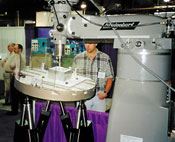This Hexapod You Can Work With
Take a standard knee-mill, identical to those found in thousands of shops around the world. On the backside of the mill, place a worktable. Under that worktable, attach six movable legs. Rotate the overarm of the mill 90 degrees so the spindle is above the rear worktable. You've created a five-axis knee mill.
Take a standard knee-mill, identical to those found in thousands of shops around the world. On the backside of the mill, place a worktable. Under that worktable, attach six movable legs. Rotate the overarm of the mill 90 degrees so the spindle is above the rear worktable. You've created a five-axis knee mill.
With the introduction of its Hexabot Series 1, Hexel Corporation (Portsmouth, New Hampshire) has built a practical hexapod that allows a shop to turn its ordinary knee-mill into a five-axis machining center. The Hexabot alters the length of its six legs to create continuous motion for machining contoured workpieces in a single setup that would take several handlings on a conventional three-axis machine.
It has been several years since the metalworking world was first introduced to the concept of hexapod technology. Basically the key advantage of this concept was to introduce a machine tool that was dependent on mathematical algorithms for accuracy instead of mechanical relationships among components.
With a hexapod, the need to create very accurately aligned planes such as a column and base is not relevant. Rather, the accuracy of a hexapod machine tool resides in the complex mathematics within the control software. About the only precision mechanical components are the six ballscrews, which work together to actuate the axes of motion.
Commercial acceptance of the hexapod machining center has been slow. Hexel sees this new Hexabot as an incremental step for shops to use the flexibility of hexapod technology for metalcutting without a large up-front investment. Moreover, the risk of a relatively new technology is mitigated by the shop's ability to revert back to conventional three-axis milling if necessary.
"The odds are," says Michael Fortier, Hexel's vice president of advanced technology, "most shops that install this system behind their knee-mills will find themselves using it for jobs they once made using conventional three-axis machining." The Hexabot table is CNC driven and uses a PC-based interface and software package that allows five-axis part production using standard CNC programming.
In operation, the Hexabot is placed directly behind a standard knee-mill. Its footprint is 40 inches by 40 inches. Overall height of the table, fully extended, is 40 inches.
Once the knee-mill overarm is rotated 90 degrees, the machine's quill is locked in place. All of the axial motion is derived from the Hexabot table itself. Accuracies are quoted at ± 25 microns (± 0.001 inch). A maximum feed rate of 200 inches per minute can be programmed for the table. Its weight capacity is 250 pounds.
The six legs of the positioning table work in opposite pairs. When one leg is in tension, its opposite is in compression. This gives the design a high level of rigidity in both static and dynamic modes.













.png;maxWidth=300;quality=90)




